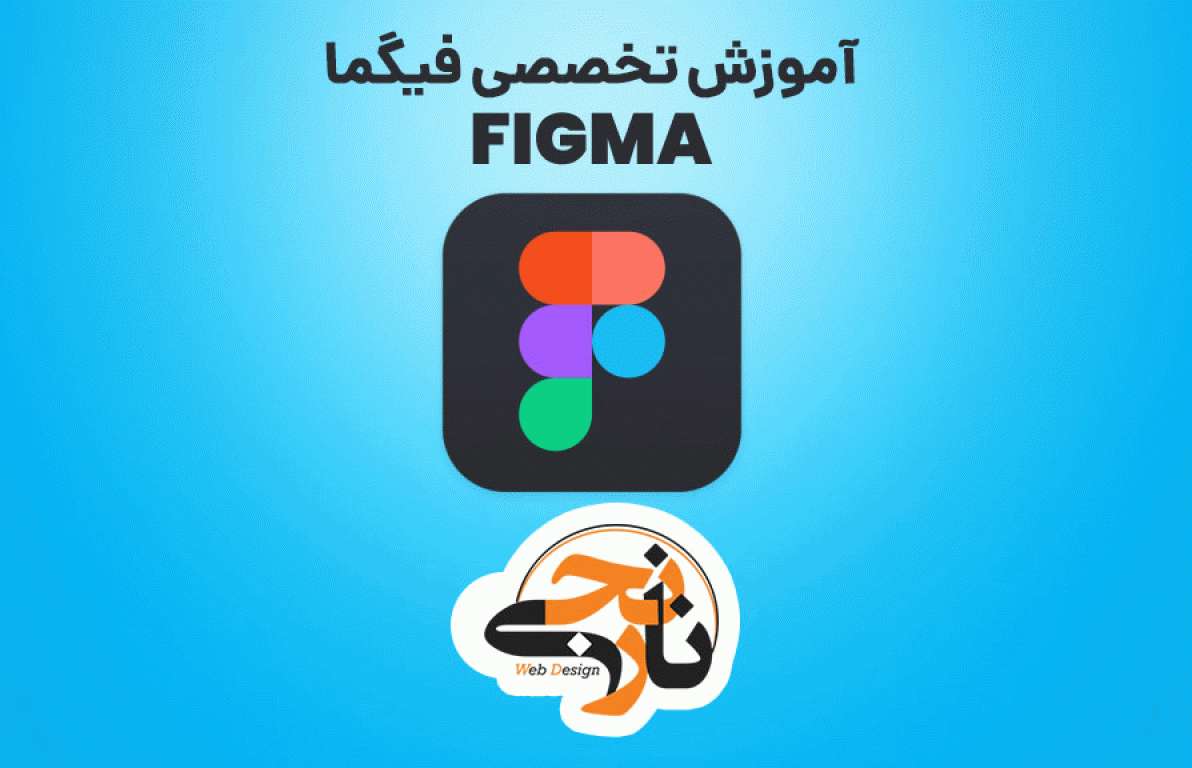Figma is a design and development tool for web and mobile that helps designers and developers create, design, and test their user interfaces and websites.
Figma is a popular design and development tool worldwide for web and mobile design, which will be professionally and privately taught by the Narenji team. This tool allows designers and developers to easily design, test, and share complex user interfaces, websites, and mobile apps. With its unique features, Figma enables designers to quickly and accurately bring their designs to life and optimize their ideas through multiple tests.
One of Figma's prominent features is its ability to collaborate and synchronize among team members. This tool enables simultaneous viewing and editing of designs, allowing multi-member teams to work together on a project in real-time without the need to send files and new versions.
Additionally, Figma offers features for testing and evaluating designs, such as interactive prototyping, user feedback and comments, as well as automatic CSS code generation and handoff to developers. These features make the process of developing and testing user interfaces faster and more efficient.
With Figma, designers can pay more attention to the details of their designs and improve their designs through test results and user feedback. This tool has established itself as a very popular tool among designers and developers in the community for web and mobile development.
In general, Figma training can be presented in several ways, including:
1. Professional training by the Narenji team: The Narenji team provides professional Figma training, a collection of official tutorials and video tutorials that cover topics from beginner to advanced in this tool. These tutorials are available online and in Figma training packages.
2. Online courses: Websites and online platforms such as Udemy, Coursera, LinkedIn Learning, etc., offer courses on using Figma. These courses may be created by independent specialists or educational companies.
3. Written resources: Books, articles, blogs, and official Figma documentation can be useful educational resources. These resources usually explain specific topics, techniques, and optimal methods for using Figma.
4. In-person classes: In the north, especially in the city of Amol, in-person training courses and workshops on Figma are held, providing direct teaching experience and interaction with instructors.
5. Online communities and forums: The existence of online forums, groups, and communities dedicated to Figma can serve as an excellent educational resource for asking questions, sharing experiences, and learning from others.
Additionally, to get started, you can work on designing a simple project in Figma and then, by referring to the mentioned resources above and continuous practice, strengthen your skills in this tool.
In general, a Figma training curriculum can include several topics such as:
Introduction to Figma:
1. Introduction to Figma: Overview and history of Figma, its purpose, and main applications.
2. Installation and setup: Installing and setting up Figma on various operating systems.
Design Basics in Figma:
3. Introduction to the Figma interface: Familiarization with the user interface and main components in Figma.
4. Initial design: Creating pages and basic elements in Figma.
5. Working with Layers: Understanding layers and managing elements in Figma.
6. Using Components: Using components to create and manage reusable and editable elements.
Advanced Topics:
7. Responsive Design: Techniques and methods for designing responsive and multi-screen layouts.
8. Animation and Interactions: Creating dynamic and engaging animations and user interactions in Figma.
9. Testing and Evaluation: Testing and evaluating designs and basic communication with developers for output generation.
Advanced and Professional Topics:
10. Automatic code generation: Using Figma tools and plugins to automatically generate CSS code or assets.
11. Team Collaboration: Managing and collaborating with teams in Figma, including coordination and sharing projects.
12. Extending Capabilities with Plugins: Introduction to plugins and extensions in Figma to expand capabilities and increase productivity.
Practice and Practical Projects:
13. Practical Projects: Completing practical projects using Figma to reinforce learned concepts.
14. Feedback and Improvement: Iterating the learning process through feedback and continuous improvement.
Resources and Further Learning:
15. Additional Resources: Introduction to resources, books, websites, and online communities for further learning and skill updating.
Additionally, this curriculum can be tailored to meet the needs and levels of different students and professionals, covering topics from basic to advanced and professional levels.
Certainly. As with any tool, Figma has its advantages and disadvantages. Below, I'll highlight some of the pros and cons of using Figma:
Pros of Figma:
1. Efficient User Interface: Figma has an efficient and user-friendly interface that allows users to easily and quickly create their designs. With a little training, it's very intuitive and straightforward.
2. Collaboration and Coordination: The ability for simultaneous collaboration among team members, version control, and project sharing improves coordination and collaboration within teams.
3. Responsive Design Support: Figma provides various tools and features for designing responsive layouts, helping designers create designs compatible with different screen sizes.
4. Diversity and Flexibility: The ability to use components, plugins, and various extensions allows users to have more diversity and flexibility in their designs.
Cons of Figma:
1. Learning Curve: Effective use of Figma requires learning its concepts and features, which may be time-consuming and challenging for some users.
2. Subscription Cost: To access advanced features and collaborate in larger teams, a subscription and purchasing of Figma's collaborative plans are required, which can be costly.
3. Limitations in Data Exchange with Other Tools: In some cases, data exchange and compatibility with other tools and projects may have limitations, which can disrupt the workflow.
4. Internet Dependency: Figma requires an internet connection and does not provide offline functionality, which may be limiting for some users.
Taking these pros and cons into account, you can make a decision to use or not to use Figma based on your own needs and circumstances.
Market for Figma:
The market for Figma in Iran and globally in the fields of web and mobile design and development is very dynamic and growing. This tool allows designers and developers to efficiently and quickly work on designing and developing user interfaces and websites, which has increased the demand for experts proficient in Figma.
The advantages of Figma, such as easy collaboration and coordination among team members, the ability to develop responsive designs, use of components and plugins, and the ability to automatically generate CSS code and assets, have made it a key and vital tool in the web and mobile design and development process.
Since Figma is a global tool and facilitates sharing and collaboration in international teams, Figma experts can easily search for jobs in the global job market through various online platforms and using different languages. This tool enables designers and developers to participate in projects worldwide from anywhere, gaining recognition as international professionals.
Figma, as a professional UI/UX design and development tool, has many advantages that make it an ideal choice for designers and developers. Here are several reasons why choosing Figma as the main tool is recommended:
1. Easy Collaboration and Coordination:
Figma provides tools and features that allow teams to work together easily and harmoniously. The ability for simultaneous collaboration and real-time viewing and editing of designs enables teams to develop their projects with high quality using a harmonized and integrated approach.
2. Easy to Use:
Figma's simple and user-friendly interface allows designers and developers to easily familiarize themselves with the tool and create creative and professional designs using its features.
3. Support for Responsive Design:
Figma offers various tools and features for designing responsive layouts, enabling designers to create designs compatible with various screen sizes and provide a suitable user experience for users.
4. Support for Plugins:
Figma enables the use of various plugins and extensions, allowing users to extend its capabilities and functionalities according to their needs.
5. Professional Support and Training:
The Narenji Group provides official and professional training on the use of Figma. These trainings cover topics from basic to advanced and help users improve their skills in UI/UX design and development.
6. Comprehensive and Scalable:
Figma is a comprehensive tool that its developers continuously add new features and capabilities to. This ensures that the tool is constantly improving and becoming more scalable for users.
Figma Training by the Narenji Group:
The Narenji Group is proud to offer you professional and effective training in the use of Figma design tools. We focus on providing high-quality and comprehensive educational content to help you gain the necessary skills for professional UI/UX design and development and enter the job market. By covering topics from beginner to advanced and using the best teaching methods, we will help you make the best use of design tools and advance in your professional career. We look forward to seeing you in our training courses.
For more information and details, please contact us: +989119171500
Mr.Ghorbani - Narenji Group





